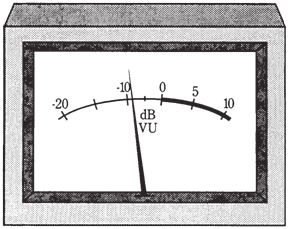VU and decibel meters
In high-fidelity equipment, especially the more sophisticated amplifiers, loudness meters are sometimes used. These are calibrated in decibels, a unit that you will sometimes encounter in reference to electronic signal levels. A decibel is an increase or decrease in sound or signal level that you can just barely detect, if you are expecting the change.
Audio loudness is given in volume units, and the meter which indicates it is called as VU meter. Usually, this types of meters have a zero marker with the red line to right and a black line to left, and they are calibrated in decibels above and below this zero. The meter might be calibrated in watts RMS, an expression for audio power.
As music is played through system, or as a voice comes over it, the VU meter needle will begin. The amplifier volume should be kept down so that the meter does not go past the zero mark and into red range. If the meter does kick up into the red scale, it means that distortion is taking place within the amplifier circuit only.
Sound level in general can be measured by means of a sound-level meter, calibrated in decibels (dB) and connected to the output of a accuracy amplifier with the microphone of known, standardized sensitivity. You have perhaps heard that a vacuum cleaner will generate 80 dB of sound, and a large truck going by can subject your ears to 90 dB. These figures are determined by the sound-level meter. A VU meter is a special type of sound level meter.

Figure: A VU meter. The heavy scale is red, indicating high risk of the audio distortion.

Figure: A sound-level meter.